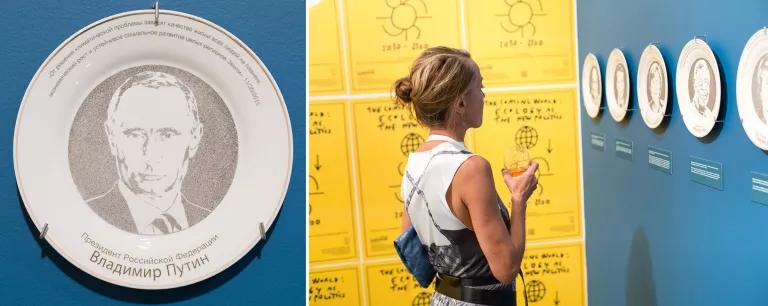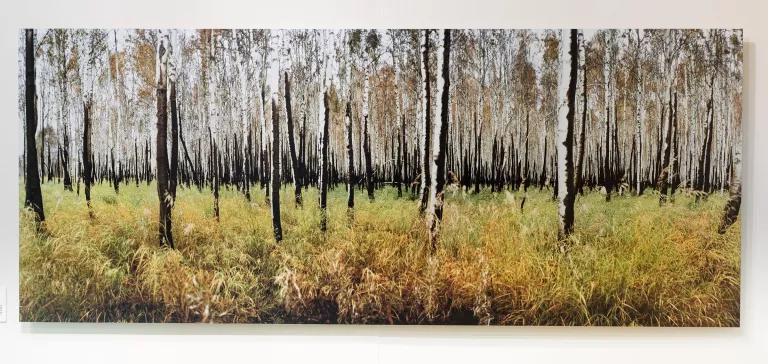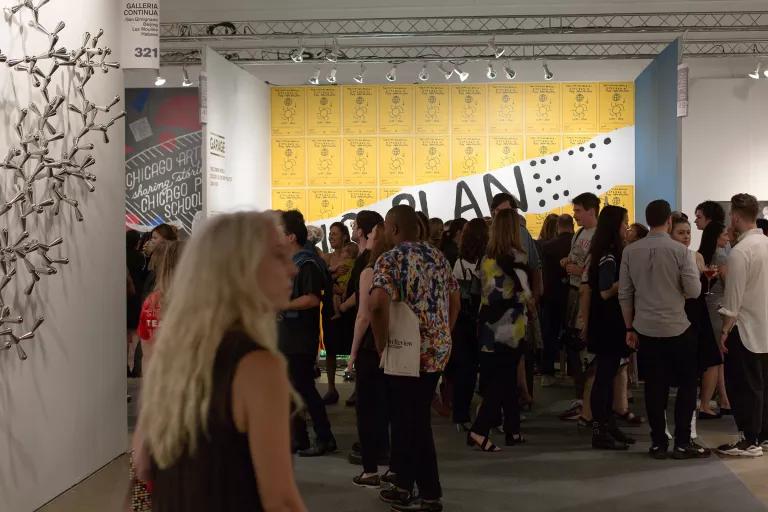The Faces of Trump and Putin, Stenciled in Smog
From Chicago to Moscow, this artistic collaboration puts climate change on display—and world leaders on notice.

“No Planet” by Dan Perjovschi
Back in June, American artist Kim Abeles carefully put a set of porcelain plates on a rooftop in her hometown of Los Angeles. On each plate was a different stencil she had made of 10 world leaders. Along with their faces, the stencils quoted the politicians’ words on climate change. Abeles chose many of the quotations because they were inspirational, such as German Chancellor Angela Merkel’s, but she chose others, such as President Trump’s, for their irony.
“The United States, under the Trump administration, will continue to be the cleanest and most environmentally friendly country on Earth. We’ll be the cleanest. We’re going to have the cleanest air. We’re going to have the cleanest water,” Trump’s stencil reads.
Next to the face of Russian President Vladimir Putin, are these words: “The quality of life of everyone on the planet and the economic growth and sustainable social development of entire regions depend on our ability to resolve the climate problem.”
The records for both of these leaders on climate change, mind you, are abysmal.
Abeles laid out her stencils a few times in different neighborhoods, using a process she perfected 32 years ago. While the plates sat on roofs for two weeks, the particulate matter in the surrounding smog—caused by combustion engines and fossil fuel-burning power plants—drifted through the cutout sections, graying the white plate beneath, and slowly made an image like a developing photograph. Last month, the plates hung on the wall of a booth at the annual International Exposition of Contemporary and Modern Art in Chicago.

“How do you balance this idea of being inspired while getting the confrontation of their portraits made of smog?” the artist says of the featured world leaders. “I felt that it really made them accountable for their words in a lot of ways.”
Abeles was one of four artists featured in a booth commissioned by NRDC for EXPO Chicago. The others were Russian photojournalist Denis Sinyakov, whose photograph of an untouched birch forest near Siberia’s Baikal Nature Reserve turns out on closer inspection to be a stand of trees charred by wildfire; Russian artist Alexander Obrazumov, whose installation of plants growing out of fluorescent lights symbolizes the absurdity of green marketing that promotes “mindfulness” during times of ecological crisis; and Romanian artist Dan Perjovschi. The latter’s eye-catching bright-yellow posters (printed with soy on recycled paper for the event) covered one wall, with a slash of white running across them with the words “No Plan(et).”

This year’s EXPO was held the same week that representatives from close to 200 nations convened in New York City for the U.N. Climate Summit—and while millions of young people all over the world took to the streets to demand climate action and justice.
Each work at EXPO was a new iteration of installations now on display at Moscow’s Garage Museum of Contemporary Art. Showing at the museum until December 1 is “The Coming World: Ecology as the New Politics 2030–2100,” an exhibit featuring more than 50 artists from over 15 countries across the globe.
The four artists chosen for EXPO demonstrate a mix of cultural backgrounds with varying messages about the ongoing environmental emergencies like climate change and pollution—realities that would resonate with both Americans and Russians, says Valentina Osokina, project manager at Garage who oversaw the artists’ work at EXPO.
“I think it’s absolutely vital and extremely important that in these turbulent times we find common ground,” says Osokina. “We can talk, and we see that we are all united by the same problems.”
NRDC began commissioning artwork for EXPO in 2011, but this was the first time the organization (which publishes onEarth) reached out to an international partner. Over the years NRDC has featured a topographical map of the Chicago River made of pins by Maya Lin, an origami elephant by Sipho Mabona, and Brandon Ballengée’s work featuring historic prints and publications of wildlife, except with the animals cut out to symbolize extinction.

Visitors of the “The Coming World: Ecology as the New Politics 2030–2100” exhibit
David C. Sampson
“Politics and policy often follow culture, and art influences culture,” said Andrew Wetzler, managing director of NRDC’s Nature program, who spoke at a panel discussion during EXPO on the value of using art to bring attention to environmental issues.
Just down the aisle from the NRDC booth, Brooklyn-based artist Zaria Forman featured huge images of shifting ice sheets in Antarctica and the Arctic. Another booth described the role of artists as documentarians, some of whom creatively capture the hardships that climate change inflicts on people and communities on the front lines of a warming world.
Osokina hopes viewers of these pieces continue to absorb the message that nature and the environment are a part of us. “We cannot just go there when we want to,” she says. “We are there already every day, and we have to take care of it as we take care of ourselves.”
For Abeles’s part, she plans to continue her environmental activism work. Over the summer, she sent freshly stenciled plates to Moscow. There they sat on the Garage’s rooftop, filling the faces and the words of politicians with soot—and truth.
This article was originally published on onEarth, which is no longer in publication. onEarth was founded in 1979 as the Amicus Journal, an independent magazine of thought and opinion on the environment. All opinions expressed are those of the authors and do not necessarily reflect the policies or positions of NRDC. This article is available for online republication by news media outlets or nonprofits under these conditions: The writer(s) must be credited with a byline; you must note prominently that the article was originally published by NRDC.org and link to the original; the article cannot be edited (beyond simple things such grammar); you can’t resell the article in any form or grant republishing rights to other outlets; you can’t republish our material wholesale or automatically—you need to select articles individually; you can’t republish the photos or graphics on our site without specific permission; you should drop us a note to let us know when you’ve used one of our articles.

Should I Become a Poll Worker?
Clean Energy Has Struggled During the Current Economic Crisis—but It’s Strong Enough to Recover
Trump’s Anti-Environment Agenda for 2020: When Opportunism Knocks